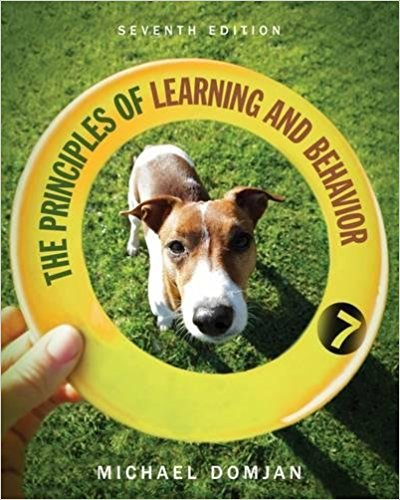Description
Test Bank for The Principles of Learning and Behavior, 7th Edition, Michael Domjan
Table of Contents
1. Background and Rationale for the Study of Learning and Behavior.
2. Elicited Behavior, Habituation, and Sensitization.
3. Classical Conditioning: Foundations.
4. Classical Conditioning: Mechanisms.
5. Instrumental Conditioning: Foundations.
6. Schedules of Reinforcement and Choice Behavior.
7. Instrumental Conditioning: Motivational Mechanisms.
8. Stimulus Control of Behavior.
9. Extinction of Conditioned Behavior.
10. Aversive Control: Avoidance and Punishment.
11. Comparative Cognition I: Memory Mechanisms.
12. Comparative Cognition II: Special Topics.
1. Pavlov’s study of classical conditioning began as an extension of his work on
a. digestion. b. pain.
c. the auditory system. d. the knee-jerk reflex.
ANSWER: a
REFERENCES: Page 58
KEYWORDS: Fact
2. Pavlov supplemented the funds for his laboratory by which of the following?
a. training dogs for the upper class b. selling stomach juice
c. teaching pitch recognition
d. inserting fistulas into obese individuals
ANSWER: b
REFERENCES: Page 58
KEYWORDS: Fact
3. Object learning involves making an association between which of the following?
a. any two naturally occurring stimuli b. the same feature of two objects
c. different features of the same object
d. an arbitrary stimulus and a biologically relevant stimulus
ANSWER: c
REFERENCES: Page 59
KEYWORDS: Fact
4. After giving your cat fish-shaped treats time and time again, you notice the cat begins to salivate at the sight of the fish-shaped snack. This is an example of
a. differential learning. b. sequential learning.
c. taste aversion learning. d. object learning.
ANSWER: d
REFERENCES: Page 59
KEYWORDS: Concept
5. A hungry rat is exposed to a red light, followed by brief access to food. After several such trials, the rat approaches the light bulb when it is illuminated. In this example, the light is
a. an unconditional stimulus. b. a conditional stimulus.
c. an unconditional response. d. a conditional response.
ANSWER: b
REFERENCES: Page 60
KEYWORDS: Concept
6. Conditional Stimulus is to Unconditional Stimulus as a. unlearned is to learned.
b. eliciting stimulus is to orienting stimulus. c. trained is to untrained.
d. independent is to dependent.
ANSWER: c
REFERENCES: Page 60
KEYWORDS: Concept
7. A rat is trained to press a lever for a small amount of food. While pressing the lever at a steady rate, the rat is presented with a tone-light stimulus that had been previously paired with foot-shock. When the tone-light stimulus is on, the rat decreases its rate of lever pressing. This decrease is an example of
a. sign tracking.
b. conditioned suppression. c. conditioned repression.
d. unconditioned fear responding.
ANSWER: b
REFERENCES: Page 62
KEYWORDS: Concept
8. Which of the following is commonly used as a measure in studies of fear conditioning?
a. freezing behavior
b. conditioned suppression c. lick-suppression
d. all of the above
ANSWER: d
REFERENCES: Page 62
KEYWORDS: Fact
9. There has been a renewed interest in human eyeblink conditioning because of which choice below?
a. Animals are expensive to maintain.
b. Progress has been made in understanding the neurobiological substrate of this type of learning. c. We understand so little about this type of learning.
d. It is a very complex behavior that we can easily observe.
ANSWER: b
REFERENCES: Page 63
KEYWORDS: Fact
10. The essential circuits for eyeblink conditioning appear to be located in the a. hippocampus.
b. cerebral cortex. c. cerebellum.
d. corpus callosum.
ANSWER: c
REFERENCES: Page 64-66
KEYWORDS: Fact
11. The cells that act as “teachers” selecting the connections to be modified in the cerebellum due to eyeblink
conditioning are which of the following?
a. the climbing fibers b. the mossy fibers
c. the cells of the red nucleus
d. the cells of the hippocampus
ANSWER: a
REFERENCES: Page 65
KEYWORDS: Fact
12. In eyeblink conditioning, the CS information is conveyed in the cerebellum via which of the following?
a. climbing fibers b. mossy fibers
c. cranial motor neurons d. olivary neurons
ANSWER: b
REFERENCES: Page 65
KEYWORDS: Fact
13. In eyeblink conditioning, the US information is conveyed in the cerebellum via a. mossy fibers.
b. auditory neurons. c. climbing fibers.
d. pontine neurons.
ANSWER: c
REFERENCES: Page 65
KEYWORDS: Fact
14. The is necessary for delay eyeblink conditioning; the is necessary if there is a trace. a. hippocampus; cerebellum
b. frontal cortex; cerebellum c. cerebellum; hippocampus d. cerebellum; frontal cortex
ANSWER: c
REFERENCES: Pages 65-66
KEYWORDS: Fact
15. In order for food to be presented in an autoshaping procedure, the pigeon must do which of the following?
a. approach the food hopper before the food is delivered b. approach the signal light before the food is delivered
c. avoid the signal light until after the food is delivered d. There are no requirements for the pigeon.
ANSWER: d
REFERENCES: Page 66
KEYWORDS: Concept
16. Which of the following is not true of sign tracking?
a. The subject need not do anything to receive the US. b. Sign tracking appears to be limited to rodent species.
c. Sign tracking can occur even if the CS and US delivery area are separated by a distance. d. Individual differences in sign tracking correlate with factors associated with drug abuse.
ANSWER: b
REFERENCES: Pages 66-68
KEYWORDS: Concept





Be the first to review “Test Bank for The Principles of Learning and Behavior, 7th Edition, Michael Domjan”